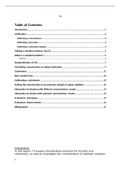Other
Unit 2 Assignment A
- Institution
- PEARSON (PEARSON)
This is assignment 2A. I have received a DISTINCTION in every assignment, so a DISTINCTION overall in unit 2. I keep it simple and follow the assignment criteria. If you have any questions or need any help, please don't hesitate to send me a message and I'll try my best to help.
[Show more]



